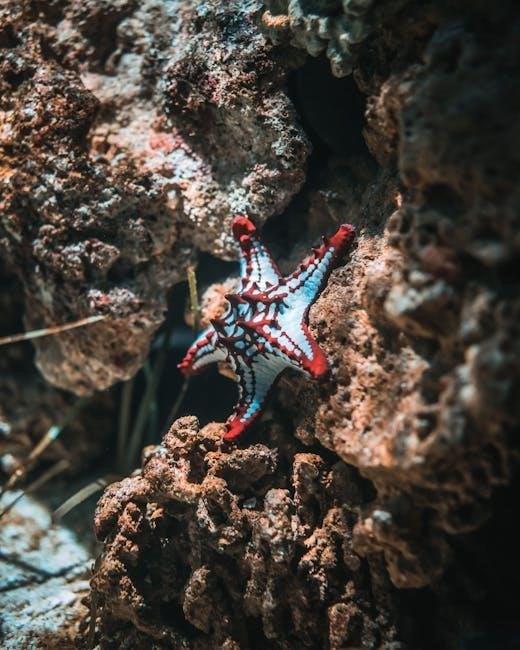Corals are fascinating marine organisms that form vibrant underwater ecosystems․ They play a crucial role in marine biodiversity and are often referred to as “rainforests of the sea․”
This guide explores coral biology‚ types‚ and conservation efforts‚ providing insights into their importance and the threats they face due to environmental changes and human activities․
What Are Corals?
Corals are marine invertebrates belonging to the phylum Cnidaria‚ closely related to sea anemones and jellyfish․ They are tiny animals that secrete a hard‚ calcium carbonate exoskeleton‚ which forms the structure of coral reefs․ Corals live in a symbiotic relationship with single-celled algae called zooxanthellae‚ which provide them with nutrients through photosynthesis․ This partnership allows corals to thrive in nutrient-poor waters․ Corals can be broadly classified into two types: soft corals‚ which are flexible and lack a rigid skeleton‚ and hard corals‚ which create the durable framework of reefs․ Coral colonies are formed by thousands of individual polyps working together‚ creating complex ecosystems that support immense biodiversity․ Despite their importance‚ corals are highly sensitive to environmental changes‚ making them vulnerable to threats like climate change and pollution․
The Importance of Corals in Marine Ecosystems
Corals are the backbone of marine ecosystems‚ playing a vital role in maintaining biodiversity and ecological balance․ Coral reefs‚ formed by hard corals‚ are among the most diverse ecosystems on Earth‚ providing habitat for thousands of marine species․ They act as nurseries for juvenile fish‚ protecting them from predators‚ and serve as feeding grounds for larger marine life․ Beyond biodiversity‚ corals protect shorelines from wave action and erosion‚ shielding coastal communities from natural disasters․ Economically‚ coral reefs support fishing industries‚ tourism‚ and livelihoods for millions of people․ Their ecological and economic value makes them indispensable‚ yet they face significant threats from climate change‚ pollution‚ and overexploitation‚ underscoring the urgent need for conservation efforts․
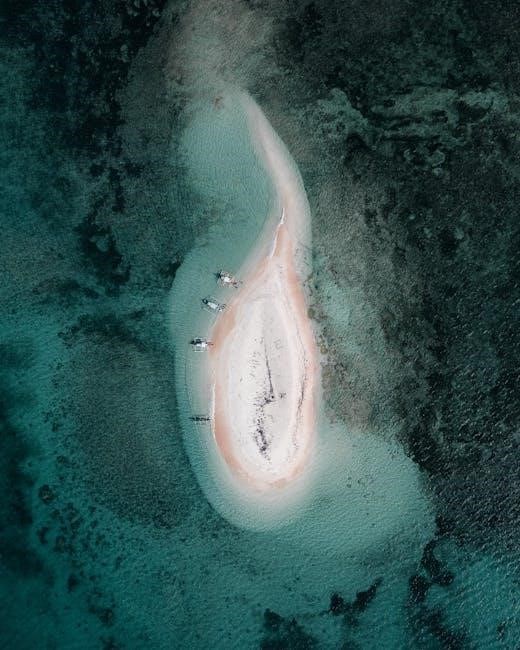
Types of Corals
Corals are classified into soft corals and hard corals‚ each with unique characteristics․ Hard corals create reefs‚ while soft corals are flexible and lack a rigid structure․
Soft Corals vs․ Hard Corals
Soft corals and hard corals differ significantly in their structure and growth habits․ Hard corals have a rigid‚ calcium carbonate skeleton that forms the foundation of coral reefs‚ providing habitat for numerous marine species․ Soft corals‚ on the other hand‚ lack this hard skeleton and are typically flexible and tree-like in appearance․ They are often found in deeper waters and are known for their vibrant colors and wavy movements in ocean currents․ While hard corals are essential for reef construction‚ soft corals contribute to the biodiversity and beauty of marine ecosystems․ Both types play vital roles in maintaining the balance of ocean environments․
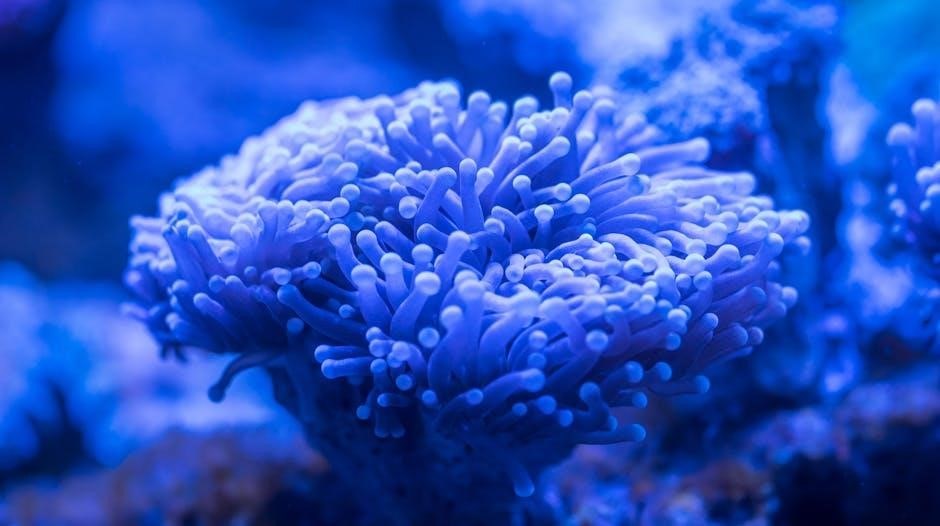
Deep-Sea Corals
Deep-sea corals thrive in the dimly lit‚ cold waters of the ocean‚ far from coral reefs․ These corals are incredibly resilient‚ surviving in harsh conditions where sunlight is scarce․ Unlike their shallow-water counterparts‚ deep-sea corals rely on bioluminescence and chemosynthetic organisms for sustenance․ They form unique ecosystems‚ providing habitats for specialized marine life․ Some species‚ like the bamboo coral‚ have been dated to be hundreds of years old‚ offering insights into ocean history․ However‚ deep-sea corals face threats from climate change‚ overfishing‚ and deep-sea mining․ Conservation efforts focus on protecting these fragile ecosystems‚ recognizing their importance in maintaining ocean biodiversity and ecological balance․ Research continues to uncover the mysteries of these remarkable underwater organisms․
Coral Identification and Classification
Coral identification involves examining colony shape‚ polyp structure‚ and color․ Classification relies on genetic and morphological traits‚ helping to distinguish species and understand their evolutionary relationships․
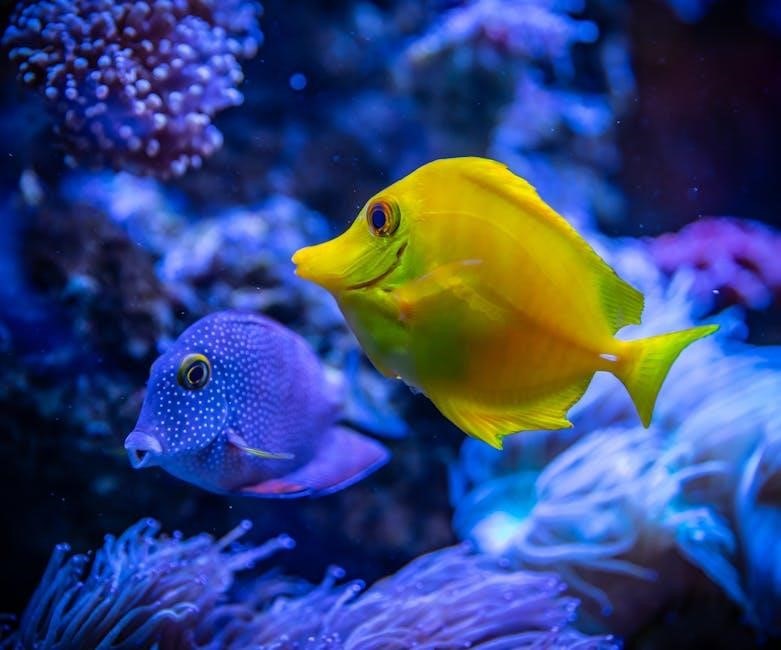
Key Characteristics for Coral Identification
Key characteristics for coral identification include colony shape‚ polyp structure‚ and color․ Colony shapes vary from branching to massive or encrusting forms․ Polyps‚ the coral’s living units‚ differ in size‚ arrangement‚ and tentacle length․ Coloration is influenced by algae symbiosis‚ with hues ranging from vibrant to muted tones․ Growth patterns‚ such as coralite structure‚ also aid in distinguishing species․ Experts often use specialized guides‚ like Russell Kelley’s Coral Finder‚ to analyze these traits․ Accurate identification is crucial for conservation and research‚ helping to protect these vital marine organisms․ By focusing on these characteristics‚ enthusiasts and scientists can better understand coral diversity and their roles in ecosystems․
Common Coral Species Found in Reefs
Coral reefs are home to numerous species‚ each with unique characteristics․ Brain corals‚ known for their hard‚ wavy surfaces‚ are among the most recognizable․ Fan corals‚ such as gorgonian species‚ are large and fan-shaped‚ while staghorn corals are branching and critical for reef frameworks․ Other common species include elk horn coral and pencil coral‚ each playing a vital role in reef biodiversity․ These corals often display vibrant colors due to their symbiotic algae‚ enhancing the reef’s visual appeal․ Understanding these species helps in appreciating their ecological importance and the challenges they face‚ such as bleaching and habitat loss․ This guide provides insights into their roles and conservation needs‚ essential for protecting these marine wonders․
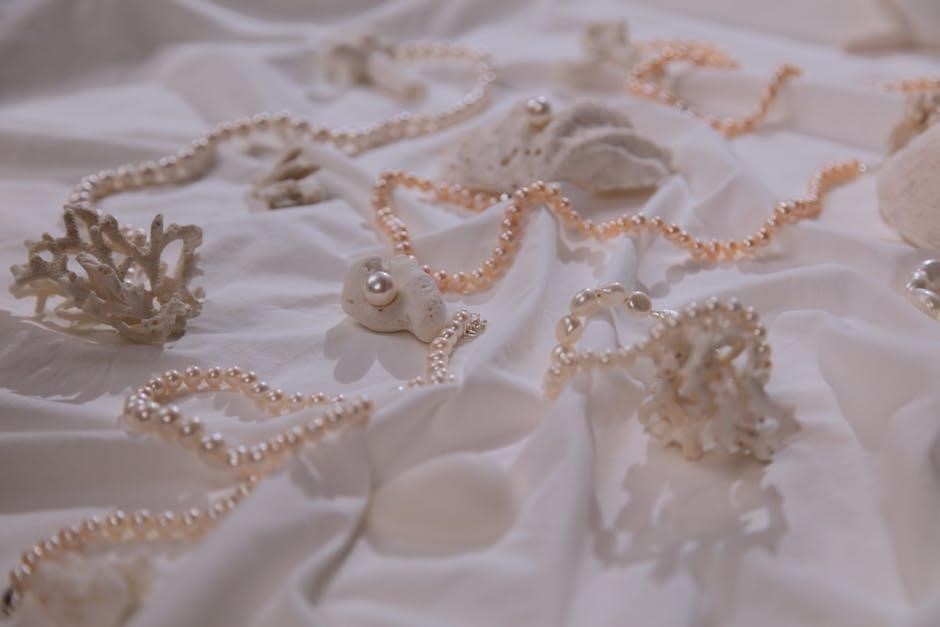
Coral Conservation
Coral conservation is vital for maintaining marine biodiversity and protecting these ecosystems from threats like climate change and pollution․ Efforts focus on reducing human impact and preserving habitats․
Threats to Coral Reefs
Coral reefs face numerous threats‚ including climate change‚ which causes rising sea temperatures leading to coral bleaching․ Pollution from land-based sources‚ such as chemicals and excess nutrients‚ also harms corals․ Overfishing disrupts the delicate balance of reef ecosystems‚ while coastal development and tourism contribute to habitat destruction․ Additionally‚ ocean acidification‚ caused by increased CO2 levels‚ weakens coral skeletons‚ making them more susceptible to damage․ These combined threats jeopardize the survival of coral reefs‚ highlighting the urgent need for conservation efforts to protect these vital ecosystems․
Marine Protected Areas and Their Role
Marine Protected Areas (MPAs) are essential for safeguarding coral reefs and their biodiversity․ These designated zones provide a refuge from human activities like fishing and tourism‚ allowing corals to recover and thrive․ MPAs help maintain healthy fish populations‚ which in turn support coral health․ They also act as nurseries for juvenile marine life‚ enhancing ecosystem resilience․ Additionally‚ MPAs can mitigate the impacts of climate change by reducing local stressors; Effective management of these areas involves collaboration between governments‚ communities‚ and conservationists․ By establishing and maintaining MPAs‚ we can ensure the long-term survival of coral reefs‚ benefiting both marine life and human communities that depend on them․
Coral Care and Aquarium Maintenance
Proper placement‚ adequate lighting‚ and stable water quality are crucial for coral health․ Regular monitoring and choosing the right coral species ensure a thriving aquarium ecosystem․
How to Choose the Right Coral for Your Aquarium
Selecting the right coral for your aquarium involves considering factors like lighting‚ water flow‚ and compatibility with other marine life․ Research coral species to ensure they thrive in your setup․ Start with hardy‚ beginner-friendly corals such as LPS or soft corals‚ which are easier to care for․ Avoid corals that require advanced care unless experienced․ Ensure the coral you choose is healthy‚ showing vibrant colors and no signs of bleaching or stress․ Acclimatize newly introduced corals gradually to prevent shock․ This careful selection process helps create a balanced and visually stunning aquarium environment․
Proper placement and lighting are critical for coral health in aquariums․ Position corals where they receive appropriate light intensity and water flow․ Avoid overcrowding‚ as this can lead to competition and stress․ Lighting requirements vary: high-light corals like SPS thrive under intense LED or T5 lights‚ while soft corals or LPS prefer lower light conditions․ Ensure a stable photoperiod of 8-10 hours to mimic natural daylight cycles․ Strong water flow helps corals exchange nutrients and stay healthy․ Place corals at levels where they receive optimal conditions for their species‚ and adjust lighting intensity gradually to prevent stress․ Proper placement and lighting ensure vibrant coloration and growth‚ creating a thriving aquarium environment․
Coral Sustainability and Human Impact
Proper Placement and Lighting for Coral Health
Proper placement and lighting are essential for coral health․ Position corals where they receive appropriate light intensity and water flow․ High-light corals like SPS thrive under intense LED or T5 lights‚ while soft corals prefer lower light․ Ensure a stable photoperiod of 8-10 hours to mimic natural daylight․ Strong water flow helps corals exchange nutrients and stay healthy․ Avoid overcrowding‚ as this can lead to competition and stress․ Place corals at levels where they receive optimal conditions for their species․ Adjust lighting intensity gradually to prevent stress․ Proper placement and lighting ensure vibrant coloration and growth‚ creating a thriving aquarium environment․
The Impact of Sunscreen on Coral Reefs
Certain chemicals in sunscreen‚ such as oxybenzone and octinoxate‚ have been identified as harmful to corals․ These substances can cause coral bleaching‚ DNA damage‚ and impair coral reproduction․ When sunscreen-laden seawater washes off swimmers’ skin‚ it can settle on coral reefs‚ disrupting their delicate ecosystems․ Even in small concentrations‚ these chemicals can have devastating effects‚ especially in shallow‚ tropical waters where corals thrive․ To mitigate this impact‚ many experts recommend using reef-safe sunscreens that contain mineral active ingredients like zinc oxide or titanium dioxide․ Additionally‚ wearing protective clothing and reapplying sunscreen less frequently can reduce the amount of harmful chemicals entering the water; Protecting corals from sunscreen pollution is a critical step in preserving marine biodiversity․
Responsible Diving Practices to Protect Corals
Responsible diving is essential to safeguard coral reefs․ Divers should never touch or stand on corals‚ as this can cause irreversible damage․ Proper buoyancy control is crucial to avoid accidental contact․ Additionally‚ divers should avoid wearing chemical-based sunscreens‚ as they can harm corals‚ and instead use reef-safe alternatives or protective clothing․ Feeding fish or other marine life disrupts the ecosystem and should be avoided․ Divers should also refrain from collecting coral specimens or marine life․ By adhering to these practices and supporting eco-conscious dive operators‚ divers can help preserve coral reefs for future generations․ Awareness and education are key to fostering sustainable diving habits․

